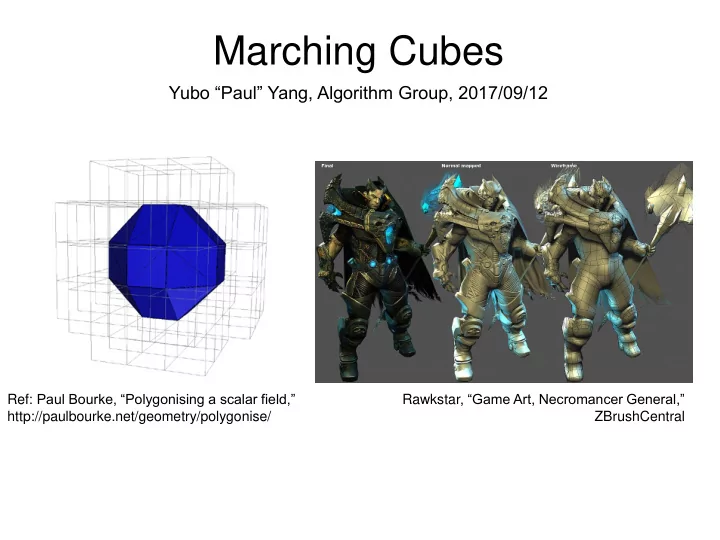

Marching Cubes Yubo “Paul” Yang, Algorithm Group, 2017/09/12 Ref : Paul Bourke, “Polygonising a scalar field,” Rawkstar , “Game Art, Necromancer General,” http://paulbourke.net/geometry/polygonise/ ZBrushCentral
Showcase I: s,p,d basis function
Showcase II: carbon diamond Hatree-Fock orbitals
“The” Problem: Isosurface Extraction Find N-1 representation of the zero-crossings of an N dimensional scalar field 𝑔 𝑦 = 0 . To simplify discussion: 1. restrict to 3 dimensions 2. assume scalar field is sampled on a regular grid Ref : Paul Bourke, “Polygonising a scalar field,” http ://paulbourke.net/geometry/polygonise/
“The” Problem: Polygonising a Scalar Field Form a facet approximation for an isosurface of a scalar field sampled on a rectangular 3D grid. 3x3x3 samples of 𝒇 −𝒔 𝟑 Triangle 1 Triangle 2 Triangle 3 … Triangle 8 Ref : Paul Bourke, “Polygonising a scalar field,” http ://paulbourke.net/geometry/polygonise/
Solution: March through the voxels (cubes) and make polygons (cubes) This is what a Gaussian looks like! Ref : Paul Bourke, “Polygonising a scalar field,” http ://paulbourke.net/geometry/polygonise/
“The” Implementation of Marching Cubes Ref: “Polygonising a scalar field”, http ://paulbourke.net/geometry/polygonise/ by Paul Bourke
“The” Implementation: Step 1 Find Intersecting Edges Ref: “Polygonising a scalar field”, http ://paulbourke.net/geometry/polygonise/ by Paul Bourke intersect edge vertex < iso. 1 11 7 0 0 10 6 0 0 9 5 0 Edge table 0 8 4 0 0 7 3 1 0 6 2 0 0 5 1 0 0 4 0 0 1 3 1 2 0 1 0 0
“The” Implementation: Step 2 Find Intersection Locations Ref: “Polygonising a scalar field”, http ://paulbourke.net/geometry/polygonise/ by Paul Bourke 𝑊 𝑗𝑡𝑝 𝑄 (𝑄 1 , 𝑊 1 ) (𝑄 2 , 𝑊 2 ) Linear Interpolation: 1 + 𝑊 𝑗𝑡𝑝 − 𝑊 1 𝑄 = 𝑄 𝑄 2 𝑊 2 − 𝑊 1
“The” Implementation: Step 3 List Triangles Ref: “Polygonising a scalar field”, http ://paulbourke.net/geometry/polygonise/ by Paul Bourke 𝑄 𝑄 3 11 𝑄 2 𝑄 3 = [ intersect at edge 3] Triangle list = [ (3,11,2) ] 𝑄 11 = [ intersect at edge 11] 𝑄 2 = [ intersect at edge 2]
Exercise Ref: “Polygonising a scalar field”, http ://paulbourke.net/geometry/polygonise/ by Paul Bourke intersect edge vertex < iso. 1 11 7 0 0 10 6 0 0 9 5 0 Edge table 1 8 4 0 0 7 3 1 0 6 2 0 0 5 1 0 0 4 0 1 0 3 1 2 0 1 1 0
Possible Ambiguity?
Constructing the Edge Table 1. Realize that there are 2 8 = 256 cases to consider. 2. Use symmetries to reduce to 15 unique cases 3. Go through each case and resolve ambiguity Wikipedia
Timing The marching cubes algorithm is almost entirely table look-up Slowness in matplotlib is likely due to 2D projection overhead (matplotlib does not do actual 3D rendering) Timing of skimage.measure.marching_cubes_lewiner on 1 core of i7-4702MQ @ 2.2GHz
Normal Mapping Dot averaged face normal vectors with light rays to determine luminescence
Modern Replacement: Surface Nets Compute the edge crossings (like we did in marching cubes) and then take their center of mass as the vertex for each cube. Fewer vertices than marching cubes Mikola Lysenko, “ Smooth Voxel Terrain ” (2012 ) S.F . Gibson, (1999) “ Constrained Elastic Surface Nets ” Mitsubishi Electric Research Labs, Technical Report.
References: [1] Paul Bourke, “ Polygonising a scalar field ” (1994) [2] Mikola Lysenko, “ Smooth Voxel Terrain ” (2012) [3] Sarah F. Gibson, “ Constrained Elastic Surface Nets ” (1999) Utilities: a click bate you will NOT regret falling for! plot basis from PySCF plot orbitals from PySCF (call the show_moR function) plot spin density from PySCF
Recommend
More recommend